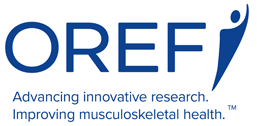

Ashley Levack, MD, MAS
RJOS/OREF/DEPUY Research Grant in Women's Musculoskeletal Health
Research Topic
Investigated whether administering tranexamic acid will reduce blood loss and the need for transfusions in patients undergoing periacetabular osteotomy
Patient Impact
Tranexamic acid administered at the time of surgical incision and at wound closure may be an effective, inexpensive, and safe intervention to decrease blood loss and allogenic transfusion rates in patients undergoing periacetabular osteotomy for acetabular dysplasia.
Making Surgery Safer and Less Costly by Reducing Blood Loss and the Need for Transfusions
RJOS/OREF/DePuy grant recipient leads randomized clinical trial
Sharon Johnson, OREF contributing writer
Could a simple surgical protocol—administering intravenous tranexamic acid (IV TXA) at the time of incision and at wound closure—help reduce blood loss and the need for transfusions for patients undergoing elective periacetabular osteotomies (PAO)? That was the question posed by an investigation led by Ashley Levack, MD, MAS, midway through her orthopaedic surgery residency at Hospital for Special Surgery (HSS), New York.
RJOS/OREF/DePuy grant “fundamental” to the study
Supported by a 2015 Ruth Jackson Orthopaedic Society (RJOS)/OREF/DePuy Research Grant in Women’s Musculoskeletal Health, Dr. Levack’s research was the first prospective, double-blinded randomized controlled trial to investigate the efficacy and clinical outcomes associated with the use of IV TXA with patients undergoing PAO.
Although IV TXA has been shown effective in reducing blood loss and transfusions after total joint arthroplasty, it has not been widely used following or much researched with PAO.
“This was a larger scale study than we could undertake without help from outside sources. The grant essentially allowed the study to be done,” Dr. Levack said.
If the research showed IV TXA to be effective in reducing blood loss and transfusions in patients undergoing PAO, a minor change in protocol could bring major rewards.
“As surgeons we often think about the technicalities of the procedure, the intricacies of the surgery itself. It’s important to think about what you can do not only during the surgery, but also after and before to help optimize outcomes. Preventing transfusions would be one way to improve outcomes for PAO patients.” Dr. Levack said.
Managing blood loss that approaches four liters
PAO is an elective procedure that reorients the hip joint, typically a response to hip dysplasia in otherwise healthy, active women, in their teens to early 30s. Because the procedure requires multiple pelvic osteotomies—cuts made to the pelvic bone to reorient the hip joint—around the acetabulum, Dr. Levack explained, patients often experience significant blood loss, approaching four liters.1-4 Allogeneic transfusion rates during PAO are as high as 58 percent;1 when combined with autologous blood and intraoperative cell saver procedures, transfusion rates can be as high as 94 percent.2
“Transfusions are not benign,” Dr. Levack said. Allogeneic transfusions bring the risk of longer hospital stays, increased costs, transmission of blood-borne infections, a range of transfusion-related reactions and injuries, and hardware infections. In addition, high-blood-loss procedures like PAO are associated with perioperative morbidity frequently caused by surgical trauma and secondary activation of the coagulation cascade as well as local fibrinolysis.5
Seeking Level 1 evidence
Dr. Levack, now an assistant professor of Orthopaedic Surgery and Rehabilitation at Loyola University Medical Center in Maywood, Illinois, conducted the study during her residency at HSS. She and her research team offered all patients aged 12-45 and scheduled for elective PAO an opportunity to enroll subject to 16 exclusion criteria. The team planned to enroll 80 patients who would be randomized so that half received IV TXA and half received a saline placebo before incision and after wound closure. With the exception of pharmacy staff, all patients, care team members, and outcomes assessors would be blinded as to whether the patients would receive IV TXA or the placebo.
All participants would be evaluated for cell saver utilization, transfusion of allogenic blood, length of hospital stay, and six specific complications at six weeks. The specific complications being tracked included venous thromboembolism (symptomatic of deep vein thrombosis or pulmonary embolism), infection (superficial, deep), hematoma, seroma, reoperation, and death.
Following administration of the first dose of intravenous study solution, each participant would be subject to elimination from the study if the surgeon, anesthesiologist or an operation room nurse suspected an adverse reaction. As two examples, an adverse reaction might be evidence of hypersensitivity or disturbance of color vision.
Dr. Levack found enrollment to be slow, with only 70% of the target total of 80 patients enrolled during the initial study period. “The population available for this trial was limited by the subspecialized nature of PAOs. Additionally, in the initial study period, the investigators encountered a lower than anticipated rate of consent for eligible patients.”
Because the investigators had been able to enroll more than 50% of the patients needed for the study in the initial period, and because the average enrollment had increased after that period, Dr Levack and her team were able to continue the study by extending the enrollment period. Dr. Levack obtained additional funding from the internal HSS Surgeon-in Chief Fund to cover the cost of this extension. With this additional support, Dr. Levack and her team completed the study. Results, which were published in the September 2020 issue of The Bone and Joint Journal6, showed a significant difference in calculated blood loss and transfusion rates, favoring the group receiving TXA.
Supporting the specialty, helping patients
Dr. Levack said the RJOS/OREF/DePuy grant made it possible for her to take advantage of the optional “step-out” year devoted to research that HSS offers its residents.
“Really high-quality research takes time and is difficult to integrate into clinical practice. Having that time to really hone my skills as a resident was an important step toward leading a research team.”
Dr. Levack is now an attending orthopaedic trauma surgeon in an academic practice, and leads a research team of residents, medical students and research coordinators within the orthopaedic trauma department. “The step-out year and ability to see [my OREF-funded] project and other projects to completion was instrumental in preparing me for an academic career, and in setting the stage for a recent award7 to support further research efforts.
In addition to the grant supporting her development as a clinician scientist, Dr. Levack said she appreciates the broader benefits of orthopaedist-supported research. “It benefits the entire orthopaedic community. The research is applicable clinically to the patients that all of us are treating. It’s important to support that research so that we can continue to move forward with clinical practice.”
References
1. Wingerter SA, Keith AD, Schoenecker PL, Baca G, Clohisy J. Does tranexamic acid reduce blood loss and transfusion requirements associated with the periacetabular osteotomy? AAOS Annual Meeting: Chicago, IL. 2013; Session P001–P110—Adult Reconstruction Hip.
2. Pulido LF, Babis GC, Trousdale RT. Rate and risk factors for blood transfusion in patients undergoing periacetabular osteotomy. J Surg Orthop Adv. 2008;17(3):185–187.
3. Lee CB, Kalish LA, Millis MB, Kim YJ. Predictors of blood loss and haematocrit after periacetabular osteotomy. Hip Int . 2013;23 Suppl 9:S8-13.
4. Thawrani D, Sucato DJ, Podeszwa DA, DeLaRocha A. Complicat ion s associated with the bernese periacetabular osteotomy for hip dysplasia in adolescents. J Bone Joint Surg Am. 2010;92(8):1707-1714.
5. Risberg B. The response of the fibrinolytic system in trauma. Acta Chir Scand Suppl. 1985;522:245–271.
6. Levack, AE, McLawhorn, AS, Dodwell, E, DelPizzo, K, Nguyen, J, Sink, E. Intravenous tranexamic acid reduces blood loss and transfusion requirements after periacetabular osteotomy. Bone Joint J 2020;102-B(9):1151–1157
7. AO Trauma North America Young Investigator Research Development Grant 2019-2021
